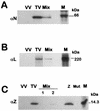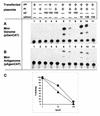Transcription and RNA replication of tacaribe virus genome and antigenome analogs require N and L proteins: Z protein is an inhibitor of these processes
- PMID: 11711615
- PMCID: PMC116121
- DOI: 10.1128/JVI.75.24.12241-12251.2001
Transcription and RNA replication of tacaribe virus genome and antigenome analogs require N and L proteins: Z protein is an inhibitor of these processes
Abstract
Tacaribe virus (TV), the prototype of the New World group of arenaviruses, comprises a single phylogenetic lineage together with four South American pathogenic producers of hemorrhagic disease. The TV genome consists of two single-stranded RNA segments called S and L. A reconstituted transcription-replication system based on plasmid-supplied TV-like RNAs and TV proteins was established. Plasmid expression was driven by T7 RNA polymerase supplied by a recombinant vaccinia virus. Plasmids were constructed to produce TV S segment analogs containing the negative-sense copy of chloramphenicol acetyltransferase (CAT) flanked at the 5' and 3' termini by sequences corresponding to those of the 5' and 3' noncoding regions of the S genome (minigenome) or the S antigenome (miniantigenome). In cells expressing N and L proteins, input minigenome or miniantigenome produced, respectively, encapsidated miniantigenome or minigenome which in turn produced progeny minigenome or progeny miniantigenome. Both minigenome and miniantigenome in the presence of N and L mediated transcription, which was analyzed as CAT expression. Coexpression of the small RING finger Z (p11) protein was highly inhibitory to both transcription and replication mediated by the minigenome or the miniantigenome. The effect depended on synthesis of Z protein rather than on plasmid or the RNA and was not ascribed to decreased amounts of plasmid-supplied template or proteins (N or L). N and L proteins were sufficient to support full-cycle RNA replication of a plasmid-supplied S genome analog in which CAT replaced the N gene. Replication of this RNA was also inhibited by Z expression.
Figures







References
Publication types
MeSH terms
Substances
LinkOut - more resources
Full Text Sources
Other Literature Sources
Miscellaneous

